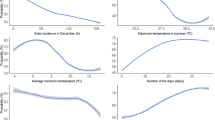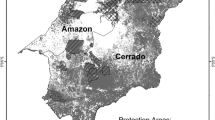Abstract
Non-native Phragmites australis ssp. australis (hereafter Phragmites) is well-established and spreading at the Long Point Peninsula. It is threatening biodiversity, making it a high priority for management. Detailed studies on rates of spread and growth patterns at the landscape-scale are needed for better informed management efforts. In this study, the spatial characteristics of Phragmites in Big Creek and Long Point National Wildlife Areas were quantified using airphoto delineations from 1945 to 2013. Three management units differing in size, habitat, and source of anthropogenic disturbance were compared. Boosted regression tree models were employed to predict future distributions to 2022. Dramatic increases in Phragmites cover (14–37% annually) far exceeding previous detections were measured starting in the mid-1990s. Dispersal was an important factor (14–66%) for spread. Expansion rates were highly variable and increased with longer perimeters. Major predicting factors were proximity to existing stands, vegetation class, and elevation. Vulnerable habitats were characterized as low lying, low sloped, marsh and shallow aquatic vegetation, and areas near water and development. Under static water-levels, Phragmites is predicted to continue spreading at near current rates to 2022 and may begin to encroach into drier habitats.







Similar content being viewed by others
References
Able KW, Hagan SM (2000) Effects of common reed (Phragmites australis) invasion on marsh surface macrofauna: response of fishes and decapod crustaceans. Estuaries 23:633–646
Altartouri A, Nurminen L, Jolma A (2014) Modeling the role of the close-range effect and environmental variables in the occurrence and spread of Phragmites australis in four sites on the Finnish coast of the Gulf of Finland and the Archipelago Sea. Ecology and Evolution 4:987–1005
Baily AR (1997) Detecting and monitoring Phragmites invasion of coastal wetlands: a comparison of remote sensing techniques. University of Delaware, Dissertation
Baldwin AH, Kettenring KM, Whigham DF (2010) Seed banks of Phragmites australis-dominated brackish wetlands: relationships to seed viability, inundation, and land cover. Aquatic Botany 93:163–169
Bart D, Hartman JM (2000) Environmental determinants of Phragmites australis expansion in a New Jersey salt marsh: an experimental approach. Oikos 89:59–69
Bart D, Burdick D, Chambers R, Hartman JM (2006) Human facilitation of Phragmites australis invasions in tidal marshes: a review and synthesis. Wetlands Ecology and Management 14:53–65
Belzile F, Labbe J, LeBlanc MC, Lavoie C (2010) Seeds contribute strongly to the spread of invasive genotype of the common reed (Phragmites australis). Biological Invasions 122:2243–2250
Bolton RM, Brooks RJ (2010) Impact of the seasonal invasion of Phragmites australis (common reed) on turtle reproductive success. Chelonian Conser Biology 9:238–243
Burdick DM, Buchsbaum R, Holt E (2001) Variation in soil salinity associated with expansion of Phragmites australis in salt marshes. Environmental and Experimental Botany 46:247–261
Catling PM, Carbyn S (2006) Recent invasion, current status and invasion pathway of European common reed, Phragmites australis subspecies australis, in the southern Ottawa district. Canadian Field-Naturalist 120:207–312
Chambers RM, Osgood DT, Bart DJ, Montalto F (2003) Phragmites australis Invasion and expansion in tidal Wetlads: interactions among Salinty, sulfide, and hydrology. Estuaries 26:398–406
Cronk JK, Fennessy MS (2001) Wetland plants biology and ecology. CRC Press, New York
Cross DH, Fleming KL (1989) Control of Phragmites or common reed. U.S. Fish and Wildlife Service. Office of Information Transfer, Ft. Collins, CO, USA. FWS/OIT- 13.4.12:1-5
Elith J, Leathwick JR, Hastie T (2008) A working guide to boosted regression trees. The Journal of Animal Ecology 77:802–813
Environment and Climate Change Canada (2016) Long Point National Wildlife Area Management Plan [Proposed]. Environment and Climate Change Canada, Canadian Wildlife Service Ontario
Gilbert JM, Oldenburg K (2013) Ecological assessment of long Point Bay, Lake Erie. 2007-2009. Vol I. Ontario Ministry of Natural Resources, Lake Erie management unit
Greenberg DA, Green DM (2013) Effects of an invasive plant on population dynamics in toads. Conservation Biology 27:1049–1057
Haslam SM (1972) Phragmite communis Trin.: biological flora of the British isles. Journal of Ecology 60:585–610
Hudon C (2004) Shift in wetland composition and biomass following low-level episodes in the St. Lawrence River: Looking into the future Canadian. Journal of Fisheries and Aquatic Science 61:603–617
Hudon C, Gagnon P, Jean M (2005) Hydrological factors controlling the spread of common reed (Phragmites australis) in the St. Lawrence River (Quebec, Canada). Ecoscience 12:347–357
Huhta A (2009) Decorative or outrageous – the significance of the common reed (Phragmites australis) on water quality. Comments from Turku University of Applied Science 48. Available via Turku Amk Turku University of Applied Sciences. http://julkaisut.turkuamk.fi/isbn9789522160867.pdf. Accessed 10 May 2017
Jodoin Y, Lavoie C, Villeneuve P, Therlault M, Beaulieu J, Belzile F (2008) Highways as corridors and habitats for the invasive common reed Phragmites australis in Quebec, Canada. Journal of Applied Ecology 45:459–466
Kettenring KM, Mock EM (2012) Genetic diversity, reproduction mode, and dispersal differ between cryptic invader, Phragmites australis, and its native conspecific. Biological Invasions 14:2489–2504
Kettenring KM, Whigham DF (2009) Seed viability and seed dormancy of non-native Phragmites australis in suburbanized and forested watersheds of the Chesapeake Bay, USA. Aquatic Botany 91:199–204
Ketternring KM, McCormick MK, Baron HM, Whigham DF (2011) Mechanisms of Phragmites australis invasion: feedbacks among genetic diversity, nutrients, and sexual reproduction. Journal of Applied Ecology 48:1305–1313
Kirk H, Paul J, Straka J, Freeland JR (2011) Long-distance dispersal and high genetic diversity are implicated in the invasive spread of the common reed, Phragmites australis (Poaceae), in northeastern North America. American Journal of Botany 98:1180–1190
Lake Huron Centre for Coastal Conservation (2008) Field guide for the control of common reed (Phragmites australis) on Lake Huron Beaches. Lake Huron Centre for Coastal Conservation. Available via French Bay Beach Association. https://frenchbay.ca/PDFs/wet_beaches.pdf. Accessed 22 April 2017
Lee H, Bakowsky W, Riley J, Bowles J, Puddister M, Uhlig P, McMurray S (1998) Ecological land classification for southern Ontario: first approximation and its application. Ontario Ministry of Natural Resources, Southcentral science section, science development and transfer branch. SCSS field guide FG-02
Maheu-Giroux M (2005) The landscape ecology of the invasive species Phragmites australis in anthropogenic linear wetlands. McGill University, Dissertation
Mazur MLC, Kowalski KP, Galbraith D (2014) Assessment of suitable habitat for Phragmites australis (common reed) in the Great Lakes coastal zone. Aquatic Invasions 9:1–19
McCormick MK, Kettenring KM, Baron HM, Whigham DF (2010) Extent and reproductive mechanisms of Phragmites australis spread in brackish wetland in Chesapeake Bay, Maryland (USA). Wetlands 30:67–74
McCormick MK, Brook HEA, Whigham DF (2016) Microsatellite analysis to estimate realized dispersal distance in Phragmites australis. Biological Invasions 18:2497–2504
Meyer SW, Badzinski SS, Petrie SA, Ankney CD (2010) Seasonal abundance and species richness of birds in common reed habitats in lake Erie. Journal of Wildlife Management 74:1559–1567
Meyerson LA, Saltonstall K, Windham L, Kiviat E, Findlay S (2000) A comparison of Phragmites australis in freshwater and brackish marsh environments in North America. Wetlands Ecology and Management 8:89–103
Philip KR, Field RT (2005) Phragmites australis Expansion in Delaware Bay salt marshes. Ecological Engineering 25:275–291
Rice D, Rooth J, Stevenson JC (2000) Colonization and expansion of Phragmites australis in upper Chesapeake Bay tidal marshes. Wetlands 20:280–299
Rohweder J, Rogala JT, Johnson BL, Anderson D, Clark S, Chamberlin F, Runyon K (2008) Application of wind fetch and wave models for habitat rehabilitation and enhancement projects. U.S. Geological Survey Open-File Report 2008–1200
Trebitz AS, Taylor DL (2007) Exotic and invasive aquatic plants in Great Lakes coastal wetlands: distribution and relation to watershed land use and plant richness and cover. Journal of Great Lakes Research 33:705–721
Tulbure MG, Johnston CA (2010) Environmental conditions promoting non-native Phragmites australis expansion in Great Lakes coastal wetlands. Wetlands 30:577–587
Tulbure MG, Johnston CA, Auger DL (2007) Rapid invasion of a Great Lakes coastal wetland by non-native Phragmites australis and Typha. Journal of Great Lakes Research 33:269–279
Van Der Wahl J, Falconi L, Januchowski J, Shoo L, Storlie C (2014) Species distribution modelling tools: tools for processing data associated with species distribution modelling exercises. SDMTools package-1.1-221. www.rforge.net/SDMTools/
Warren RS, Fell PE, Grimsby JL, Buck EL, Rilling GC, Fertik RA (2001) Rates, patterns, and impacts of Phragmites australis expansion and effects of experimental Phragmites control on vegetation, macroinvertebrates, and fish within tidelands of the lower Connecticut River. Esturaries 24:90–107
Whyte RS, Trexel-Kroll D, Klarer DM, Shields R, Francko DA (2008) The invasion and spread of Phragmites australis during a period of low water in a Lake Erie coastal wetland. Journal of Coastal Research S1(55):111–120
Wilcox D (2012) Response of wetland vegetation to the post-1986 decrease in Lake St. Clair water levels: Seed-bank emergene and beginnings of the Phragmites australis invasion. Journal of Great Lakes Research 38:270–277
Wilcox KL, Petrie SA, Maynard LA, Meyer SW (2003) Historical distribution and abundance of Phragmites australis at long point, Lake Erie, Ontario. Journal of Great Lakes Research 29:664–680
Wilson EO, Bossert WH (1971) A primer of population biology. Sinauer Associates, Inc., Stamford
Windham L, Lathrop RG Jr (1999) Effects of Phragmites australis (common reed) invasion on aboveground biomass and soil properties in brackish tidal marsh of the Mullica River, New Jersey. Estuaries 22:927–935
Acknowledgements
We are grateful to John Brett for his input during the early phases of this study and Hayley Rogers and Tina Knezevic for assistance in running the BRT models and figure development. We thank Giuseppe Fiorino for assistance with statistical analysis, and Greg Grabas and Nancy Patterson for invaluable revisions to the manuscript. We are grateful to Kerrie Wilcox and Dr. Scott Petrie for the use of their earlier vintages of vegetation delineations. We also greatly appreciate the input we received from two anonymous reviewers and the associate editor.
Author information
Authors and Affiliations
Corresponding author
Rights and permissions
About this article
Cite this article
Jung, J.A., Rokitnicki-Wojcik, D. & Midwood, J.D. Characterizing Past and Modelling Future Spread of Phragmites australis ssp. australis at Long Point Peninsula, Ontario, Canada. Wetlands 37, 961–973 (2017). https://doi.org/10.1007/s13157-017-0931-3
Received:
Accepted:
Published:
Issue Date:
DOI: https://doi.org/10.1007/s13157-017-0931-3




